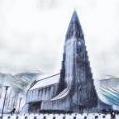Search the Community
Showing results for tags 'symmetry'.
-

symmetry Aldor: Song Cycle for Cello & Piano [POOR FORM ENTRY]
Tónskáld posted a topic in Chamber Music
I present, for your listening enjoyment (or revulsion), my entry for the Poor Form competition: Aldor, a song cycle for cello and piano. This work is a study in symmetry. As you're probably aware, tonality in music is determined by asymmetry; the intervals between notes in major/minor scales are arranged in certain tone-semitone patterns from which the human ear can determine a "home" or key for the scale. By introducing symmetry into the 12-tone scales that Western music uses, one removes a sense of tonality and instead produces atonality. French composer Olivier Messiaen further explored this in his work, "The Technique of My Musical Language." He fleshed out 7 symmetrical scales, which he called modes of limited transposition. These symmetrical scales form the basis of the harmonies you're about to listen to. The word "Aldor" is Old English, and means "life" or "vitality." This work, in impressionistic style, describes a life cycle from beginning to end—itself a form of symmetry. The opening theme is developed and undeveloped gradually across five movements, each representing a milestone in a life cycle. I have given a brief description of each movement below. Waccan. From an Old English word meaning "awakening," the opening movement presents the "cycle theme" via solo cello—simple and unadulterated. After that, the cello and piano conflict with each other in a murky 5/4 meter, closing in an F# major chord. The symmetrical scales used here are Messiaen's 1st and 2nd modes. Astígnes. This movement, meaning "a rising up or ascension," begins with a piano rendition of the cycle theme. It is afterwards joined by the cello in a dance-like rhythm and tune, reminiscent of a bouncing toddler or an empire sputtering to life. This movement features Messiaen's 2nd and 3rd modes. Hréð. The mesial movement means "triumph, victory," and represents the power of the height of a life cycle. Piano and cello combine to bring the cycle theme, followed by the most dramatic 4 minutes of the entire song cycle. This movement boasts the most virtuosic passages for cello and piano, and is based on Messiaen's 4th mode. Sweðrung. The fourth movement mirrors the second in some ways: the piano brings the cycle theme, and the tempo and rhythm are scherzo-like. However, this movement, meaning "corruption or decline," is in a disturbing 5/8 meter and lacks the "major" overtones of the second movement. It uses Messiaen's 5th mode. Ellorsíþ. The finale begins with an emotional delivery of the cycle theme by the solo cello, which is afterward joined by piano in a slow, rhythmic 9/8 meter, reminiscent of a boat sailing to undying lands (the title means "departure, journey to beyond"). Like the 4th movement, this movement mirrors the first. It also contains themes from every movement that came before it, albeit in reverse order: 4th movement themes come before 3rd movement themes, and so forth. The ending epilogue begins with a simple restatement of the cycle theme from the cello, finally joined by the piano as the cycle closes in a whispered F# major chord. This movement is based on Messiaen's beautiful 6th mode, which contains the 1st mode (cf., the first movement). This was a lot of fun to put together, and I'm grateful for the structure this competition provided! Here's a link to the songs via SoundCloud: As an amateur linguist, I would be remiss if I didn't provide some guidance on the pronunciation of the titles. So, I'll leave you with that: Waccan—WAHK-kahn; Astígnes—ah-STEEG-ness; Hréð—HRAYDH*; Sweðrung—SWEDH*-roong; Ellorsíþ-EL-lor-seeth* *"dh" is a voiced th as in they; "th" is an unvoiced th as in thanks
